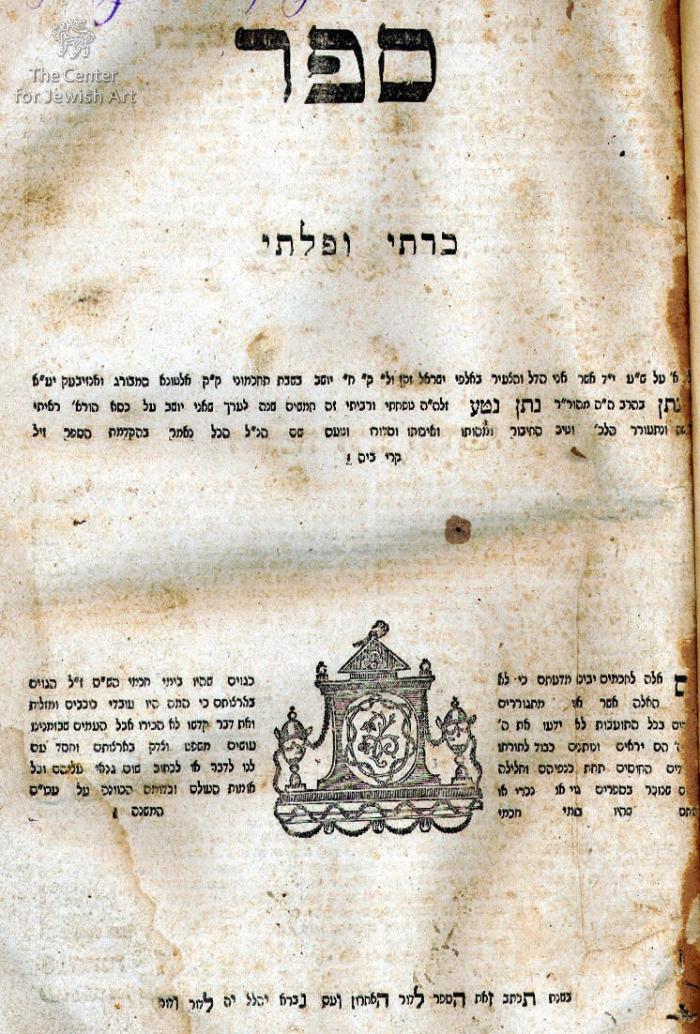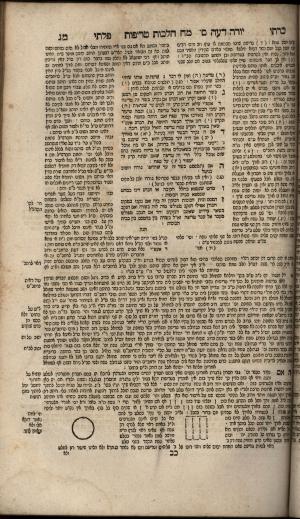Obj. ID: 36282
Jewish printed books Karti ve-Palti by Rabbi Yehonatan Eybeschütz, Żółkiew, 1799

This text was prepared by William Gross:
One of the greatest mitzvot is that of ritual purity. This large format book is a compilation of the ritual laws concerning purity, specifically dealing with the rules for Nidah and the Mikvah. The book was written by the famous Rabbi Yoehonatan Eybeschitz of Altona, the author some 30 books in the field of Halachah. Jonathan Eybeschitz (Kraków 1690 - Altona 1764), was a Talmudist, Halachist, Kabbalist, holding positions as Dayan of Prague, and later as Rabbi of the "Three Communities": Altona, Hamburg and Wandsbek. With Jacob Emden, he is well known as a protagonist in the Emden-Eybeschütz Controversy.
Eybeschütz's father was the rabbi in Ivančice (German: Eibenschütz, sometimes Eibeschutz), Moravia. Eybeschütz was a child prodigy in Talmud; on his father's death, he studied in the yeshiva of Meir Eisenstadt in Prostějov (Prossnitz), and then later in Holešov (Holleschau). He also lived in Vienna for a short time. He married Elkele Spira, daughter of Rabbi Isaac Spira, and they lived in Hamburg for two years with Mordecai ha-Kohen, Elkele's maternal grandfather. Among their descendents are the illustrious management thinker Peter Drucker and Margarethe Kelsen, the wife of Hans Kelsen.
Eybeschütz settled in Prague in 1715 and became head of the yeshivah and a famous preacher. The people of Prague held Eybeschütz in high esteem and he was considered second there only to Dayan David Oppenheim.
In Prague, Eybeschütz received permission to print the Talmud - but with the omission of all passages contradicting the principles of Christianity in consultation with Dayan David Oppenheim. Legends and rumors seeking to discredit the event said that he did this without the consultation of the Rabbis of Prague, and they revoked the printing license.
Already in Prague 1724, he was suspected of being a Sabbatean. He even got up on Yom Kippur to denounce the Sabbatean movement, but he remained suspected. Therefore, In 1736, Eybeschutz was only appointed dayan of Prague and not chief rabbi. He became rabbi of Metz in 1741. In 1750, he was elected rabbi of the "Three Communities:" Altona, Hamburg, and Wandsbek.
He was "an acknowledged genius" in at least three separate areas of Jewish religious creativity: Talmud and Jewish law (halakhah); homiletics (derush) and popular preaching; and Kabbalah. "He was a man of erudition, but he owed his fame chiefly to his personality. Few men of the period so profoundly impressed their mark on Jewish life."






